
GOULDIA POPELAIRI.
Popelaire’s Thorn-tail.
Trochilus Popelairii, Du Bus, Esquisses Orn., pi. 6.
Mellisuga Popelairii, Gray and Mitch. Gen. o f Birds, vol. i. p. 113, Mellisuga, sp. 70.
Gouldia popelairi, Bonap. Consp. Gen. Av., p. 86, Gouldia, sp. 2.—lb. Consp. Troch. in
Rev. et Mag. de Zool., 1854, p. 257-
W e r e it possible to visit the planets, in search of the hidden secrets of nature, one could scarcely expect to
find a greater number of remarkable novelties, in the way of birds, than have been revealed by the more
recent explorations among the great Andean ranges, of which the present bird is certainly not one of the
least interesting. Like the other members of the genus, to which the name of Gouldia has been given by
Prince Charles Lucien Bonaparte, it is distinguished by the elegance of its form and by the beauty of its
markings, to which in this case is added a graceful attenuated crest formed of lengthened hair-like plumes,
two of which, as will be seen on reference to the accompanying Plate, extend far beyond the rest.
The honour of first recording the existence of this species, is due to the Vicomte Du Bus of Brussels,
who, when describing and figuring it some few years since in his “ Esquisses Ornithologiques” above
referred to, named it Trochilus Popelairii, in honour of the Baron Popelaire de Terloo, who had discovered
it in Peru and enriched the museum at Brussels with this and many other interesting objects obtained
during his explorations in South America. The specimen from which M. Du Bus took his description
remained for some time unique, but I have since obtained specimens procured in Peru by M. Warszewicz,
more recently examples have been sent me from the neighbourhood of Popayan, and I am indebted to Mr.
Mark, Her Majesty’s Consul at Bogota, for a specimen collected in the vicinity of that city: it is clear then that
the species enjoys a very wide range, extending over six or eight degrees of latitude in the elevated regions
of Peru and Columbia. Mr. Mark tells me that the hot districts of Gramalote, an almost uninhabited part
of the country to the eastward of Bogota, is one of the localities in which it is found; M. Warszewicz killed
it at a considerable elevation among the Andes of Quindios; and M. Parzudaki, of Paris, informs me that
it is met with in the Llanos de San Martins in New Grenada. This, I regret to say, is all the information
I have been able to obtain respecting this little gem; we must therefore await the result of future explorations
for an account of its habits, actions and economy. That it is a quick flier I am certain, from the conformation
of its wings and its general structure.
The female offers the same difference in form from her mate that is found to exist in the sexes of Gouldia
Langsdorjji; but the bright red hue of her legs and thighs at once indicates her specific relationship.
The male has the crown of the head, the shorter feathers of the crest, face and throat shining yellowish
grass-green ; lengthened filamentous feathers of the crest black; wings purplish brown; upper surface,
wing-and upper tail-coverts golden green, across the rump a band of white expanding into a large patch on
each flank, and overhanging the thighs, below this band the golden green deepens into blackish brown; centre
of the abdomen black; flanks brown, with darker centres; under tail-coverts greyish white; upper surface
of the tail steel-blue, passing into brown on the apical portion of the external feather; the shafts of the
middle feathers white, those of the remainder white at the base and brown for the remainder of their length;
on the under surface the tail-feathers are of a more lively steel-blue, and the shafts are white throughout
their entire length; thighs aud tarsi rust-red.
The female has the upper surface, wing-coverts, flanks and tail-coverts dark bronzy green, the bronzy hue
predominating on the back ; rump crossed by a band of white, below which the feathers are of a darker hue
as in the male; chin and a stripe down each side of the neck from the angle of the mouth greyish white;
centre of the throat and abdomen bluish black; tail-featbers deep steel-blue, grey at the base and tipped
with white, the white increasing in extent as the feathers recede from the centre; thighs rust-red.
The figures represent the two sexes of the natural size. The pretty flower, Loasa picta, which, like the
bird, is a native of the Andes, is copied with permission from the Botanical Magazine, a work of great merit
and usefulness, whether we regard the scientific descriptions by Sir William J. Hooker and Mr. Smith,
or the artistic figures by Mr. Fitch.